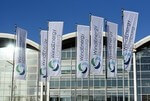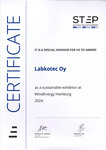02/02/2004
WindEnergy: Multi-Megawatt systems and offshore make new demands on the component supply industry
Bigger, higher, and above all low-maintenance – those are the requirements for wind energy generating systems of the future, for both onshore and offshore locations. And that also demands new highs in performance from the engineering people in the component supply industry. Alongside the big manufacturers of wind turbine systems, the component suppliers will also be prominent at WindEnergy 2004 – International Trade Fair, showing the whole range of their products and services; many of their new developments will be on show in Hamburg from 11 to 14 May. The exhibitors include SKF GmbH, Winergy AG, Bonfiglioli Getriebe GmbH and the rotor manufacturer LM Glasfiber A/S. WindEnergy is thus underscoring its significance as the specialist fair for the whole value chain of the wind industry.
The latest highlight in the component supply sector is the world’s largest rotor blade for wind turbines, which has just been completed. It is exactly 61.5 metres long, and is the first of three rotor blades for the five-megawatt system (5MW) of turbine manufacturer REpower AG, to be erected near Brunsbüttel by early summer. The blade prototypes for the first 5MW system are made in Denmark by LM Glasfiber A/S, the only independent rotor blade manufacturer operating worldwide. The 61.5 metre blade beats all records. With its rotor diameter of 120 metres, it gives a swept area of 12,568 square metres – nearly the size of a football pitch. “We make these blades in two parts and then join them together,” explains Steen Broust Nielsen of LM Glasfiber. Each blade weighs about 17 tonnes. The Danes will initially be making four of these new record-breaking 61.5m blades – three for the equally record-breaking 5M system, and one for themselves, in order to give it “really tough testing over a six to eight month period,” says Broust Nielsen.
The new, powerful systems in the multi-megawatt category demand innovative resources on the part of the suppliers – the components have to be made lighter and lighter in future. As the size of the wind energy converting system increases, the weight of the gearbox normally increases even more, because it has to handle greater torque. Thus the Flender gearbox for the 2.5MW system N80 from Nordex weighs about 20 tonnes, while the same manufacturer’s gearbox for the twice-as-powerful 5MW system from REpower weighs as much as 63 tonnes. This means total nacelle weight is 350 tonnes. The loads acting on the system as a whole are enormous. And there are limits to any further increase in these loads, because that would cause problems in structural design, transportation, erection logistics, and not least in cost.
Further requirements for the individual components of wind energy systems are that they have to remain transportable, but still be cost-effective to manufacture – tough demands on components that have to last a long time and require as little repair as possible. Maintenance and service requirements are tested by the suppliers, in some cases in their own test facilities, before the components are approved for series production. The largest test rig for gearboxes, up to 6MW, is operated by Winergy AG, the company that handles all of Flender’s wind energy operations. For offshore facilities in particular, it must be possible to do jobs such as bearing replacement in the nacelle, and there are high standards for lubricating and cooling equipment.
The most extreme requirements are those for the gearbox, which has to have a service life of two decades or more. Winergy (based in Bocholt) is one of the world leaders in this field, with more than 25,000 gearboxes for wind energy systems delivered. The Winergy Superfinishing (WinsSF) method is a surface treatment to increase the wear resistance of the gears in wind gearboxes. It is a chemical process which smoothes the surfaces and thus reduces friction-induced wear. Condition Monitoring Systems (CSM) are increasingly used by gearbox manufacturers, component suppliers and independent service providers for monitoring of the facility condition, for supervising and evaluating temperatures and vibration behaviour – for example they are used by the bearing manufacturer SKF GmbH from Schweinfurth. The SKF diagnosis capabilities include gear and bearing damage, balancing, and tower and rotor blade vibrations. SKF now have orders for their online CMS system “SKF WindCon” for some 130 wind turbines.
Many traditional industrial companies such as SKF and Service-Stahl-Center in Bremen have discovered a new and lucrative field of business in the wind energy sector. According to figures reported by the German Engineering Federation (VDMA), the wind energy generating systems themselves accounted for as much as 2.7 billion euros out of a total of 3.5 billion euros revenues of the wind energy sector in Germany in 2003. The industry is also creating a large number of jobs –more than a quarter of the workforce of the gearbox manufacturer Flender (in Bocholt) are now employed in the wind energy division. “And it’s much the same situation in foundries, where the proportion of the workforce involved in wind energy projects is likewise a double-digit percentage, between 10 and 30%”, says Johannes Schiel of the VDMA.
WindEnergy 2004 will be held from Tuesday 11 May to Friday 14 May. The opening times are 9am to 6pm, with extended opening up to 8pm on the Thursday. The international trade fair offers manufacturers and component suppliers for wind turbines, and planners, finance institutes, measurement and certification bodies and specialists from research and development an international platform for further expansion of this market of the future. The official international partners of WindEnergy are the EWEA, AWEA and the InWEA, and at national level VDMA and DEWI. Further information is available at the website www.windenergy-hamburg.de
Editorial:
Gudrun Blickle, Tel.: +49 40 35 69-2442,
mail: gudrun.blickle@hamburg-messe.de
The latest highlight in the component supply sector is the world’s largest rotor blade for wind turbines, which has just been completed. It is exactly 61.5 metres long, and is the first of three rotor blades for the five-megawatt system (5MW) of turbine manufacturer REpower AG, to be erected near Brunsbüttel by early summer. The blade prototypes for the first 5MW system are made in Denmark by LM Glasfiber A/S, the only independent rotor blade manufacturer operating worldwide. The 61.5 metre blade beats all records. With its rotor diameter of 120 metres, it gives a swept area of 12,568 square metres – nearly the size of a football pitch. “We make these blades in two parts and then join them together,” explains Steen Broust Nielsen of LM Glasfiber. Each blade weighs about 17 tonnes. The Danes will initially be making four of these new record-breaking 61.5m blades – three for the equally record-breaking 5M system, and one for themselves, in order to give it “really tough testing over a six to eight month period,” says Broust Nielsen.
The new, powerful systems in the multi-megawatt category demand innovative resources on the part of the suppliers – the components have to be made lighter and lighter in future. As the size of the wind energy converting system increases, the weight of the gearbox normally increases even more, because it has to handle greater torque. Thus the Flender gearbox for the 2.5MW system N80 from Nordex weighs about 20 tonnes, while the same manufacturer’s gearbox for the twice-as-powerful 5MW system from REpower weighs as much as 63 tonnes. This means total nacelle weight is 350 tonnes. The loads acting on the system as a whole are enormous. And there are limits to any further increase in these loads, because that would cause problems in structural design, transportation, erection logistics, and not least in cost.
Further requirements for the individual components of wind energy systems are that they have to remain transportable, but still be cost-effective to manufacture – tough demands on components that have to last a long time and require as little repair as possible. Maintenance and service requirements are tested by the suppliers, in some cases in their own test facilities, before the components are approved for series production. The largest test rig for gearboxes, up to 6MW, is operated by Winergy AG, the company that handles all of Flender’s wind energy operations. For offshore facilities in particular, it must be possible to do jobs such as bearing replacement in the nacelle, and there are high standards for lubricating and cooling equipment.
The most extreme requirements are those for the gearbox, which has to have a service life of two decades or more. Winergy (based in Bocholt) is one of the world leaders in this field, with more than 25,000 gearboxes for wind energy systems delivered. The Winergy Superfinishing (WinsSF) method is a surface treatment to increase the wear resistance of the gears in wind gearboxes. It is a chemical process which smoothes the surfaces and thus reduces friction-induced wear. Condition Monitoring Systems (CSM) are increasingly used by gearbox manufacturers, component suppliers and independent service providers for monitoring of the facility condition, for supervising and evaluating temperatures and vibration behaviour – for example they are used by the bearing manufacturer SKF GmbH from Schweinfurth. The SKF diagnosis capabilities include gear and bearing damage, balancing, and tower and rotor blade vibrations. SKF now have orders for their online CMS system “SKF WindCon” for some 130 wind turbines.
Many traditional industrial companies such as SKF and Service-Stahl-Center in Bremen have discovered a new and lucrative field of business in the wind energy sector. According to figures reported by the German Engineering Federation (VDMA), the wind energy generating systems themselves accounted for as much as 2.7 billion euros out of a total of 3.5 billion euros revenues of the wind energy sector in Germany in 2003. The industry is also creating a large number of jobs –more than a quarter of the workforce of the gearbox manufacturer Flender (in Bocholt) are now employed in the wind energy division. “And it’s much the same situation in foundries, where the proportion of the workforce involved in wind energy projects is likewise a double-digit percentage, between 10 and 30%”, says Johannes Schiel of the VDMA.
WindEnergy 2004 will be held from Tuesday 11 May to Friday 14 May. The opening times are 9am to 6pm, with extended opening up to 8pm on the Thursday. The international trade fair offers manufacturers and component suppliers for wind turbines, and planners, finance institutes, measurement and certification bodies and specialists from research and development an international platform for further expansion of this market of the future. The official international partners of WindEnergy are the EWEA, AWEA and the InWEA, and at national level VDMA and DEWI. Further information is available at the website www.windenergy-hamburg.de
Editorial:
Gudrun Blickle, Tel.: +49 40 35 69-2442,
mail: gudrun.blickle@hamburg-messe.de
- Source:
- Hamburg Messe und Congress GmbH
- Author:
- Hamburg Messe und Congress GmbH
- Email:
- gudrun.blickle@hamburg-messe.de
- Keywords:
- WindEnergy, suppliers, Flenderer, LM Glasfiber



















